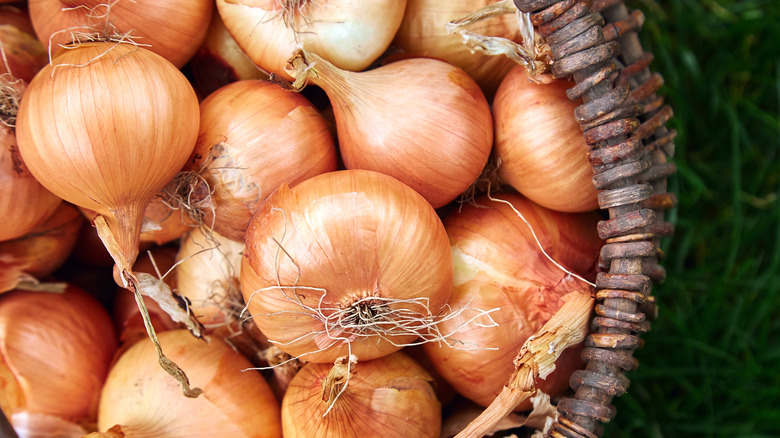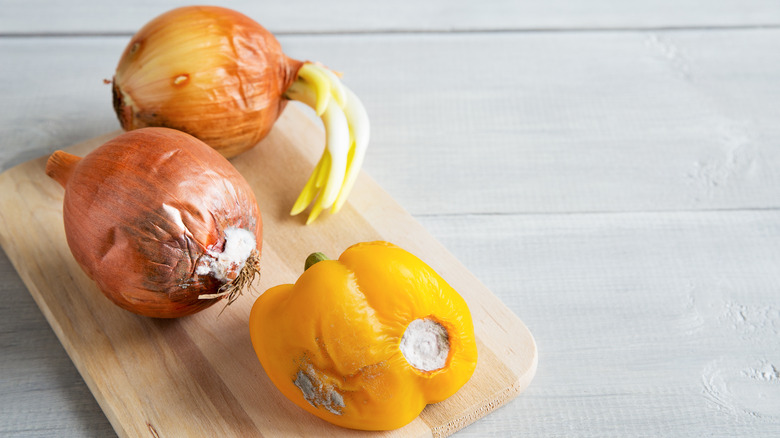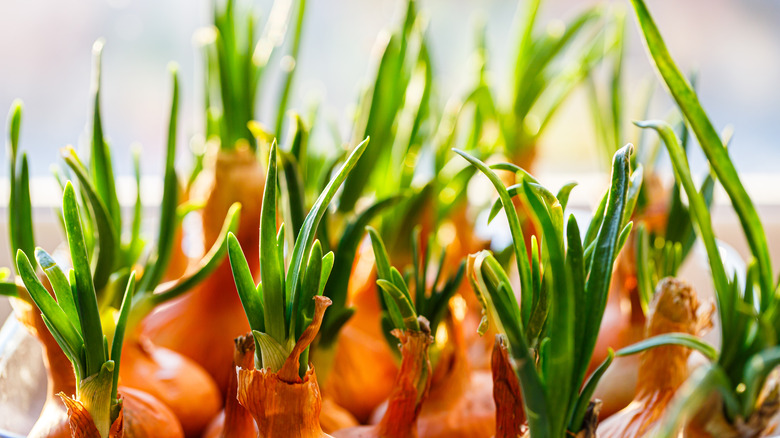Is It Dangerous To Eat An Onion That's Slightly Brown Inside?
We all know it's a tear-jerking task to cut an onion, and now that storing the pungent produce in the fridge, shielding your eyes with sunglasses, and munching on chewing gum keeps the eyes dry for some, it's time to talk about how to keep these layered vegetables alive. The outer shell can be deceiving, leaving you assuming the vidalias you have in the pantry are good to go for tonight's stir-fry. Only to find that some layers are fresh, while others are that unsightly brown color. Do you toss the whole thing? Here's everything you need to know when this happens, because let's face it, it happens to everyone.
Hmm ... the outside looks fine. It feels fine. No mush in sight, but it's not like you can cut it in half in the middle of the supermarket to really tell. A handy-dandy tool we all have that can come in handy is our nose. According to EatingWell, a rotten or composted odor will come from onions that have some sort of brown mush on the interior. The sniff test can guarantee a good onion to a bad one, without whipping out a chef's knife in the produce aisle. However, a perfectly good onion can turn to mush with time. As they age, they go through some changes that might give you pause before cooking with them.
Do onions have red flags?
It's similar to trimming a block of cheese or eating around the brown spots of an apple. If most of the onion is fresh with only a few dark lines, you should be able to salvage the good stuff. However, mold is a different story. On the interior, if you notice thin white pores, it's a key indicator that mold is growing and the onion is no longer safe to eat (via EatingWell).
It's a bumpy ride from the farm to the grocery store, and bruising is a key factor in these unpleasant spots. Like apples, when you drop an onion, it turns soft. According to The Chronicle Express, a fungus called Aspergillus niger grows on damaged and bruised fruits. Once the exterior paper of onions starts to form black spots that resemble dirt, it's a sign that mold has taken over and it's time to toss. Don't be fooled — many people assume it's soil from the farm and the onions are really that fresh, but blue marks embedded in the paper are an ultimate red flag (per Mashed).
Are sprouted onions bad?
When sweet potatoes grow sprouts, it's a sign that the plant is still very much alive and okay to eat. While you might want to trim the tough knobs off, the sprouts resembling chives or scallions that grow from the top of onions are totally safe to consume. These bright green beauties feed on the onion. When cutting it in half, if you notice brown spots towards the root of the sprout, it's a no-go. Recipe Maker states that sprouts are a sign that the onion has been sitting at the store for a while, leaving for a shorter lifespan at home. Basically, if you see sprouts at the store, leave them alone. If you notice your already-purchased onions growing sprouts, cut 'em in half and check 'em out.
So now that we know what to look for, what is the shelf life of an onion and how do we prolong it? According to Allrecipes, when stored in a dark, cool, dry space (ideally between 45°F and 55°F), whole onions can last from two to three months. For a longer lifespan guaranteed, it's less risky to store them in the fridge. Even the most beautiful vidalia will reach its peak and start to shrivel, but with the help of these tips you'll have a keen sense of which onions are good to cook or get the boot.


